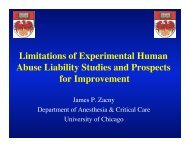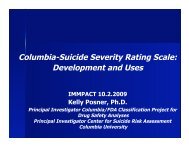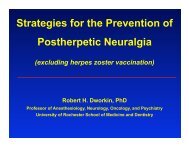Improving Assay Sensitivity In Phase 3 Trials: Existing Data - immpact
Improving Assay Sensitivity In Phase 3 Trials: Existing Data - immpact
Improving Assay Sensitivity In Phase 3 Trials: Existing Data - immpact
You also want an ePaper? Increase the reach of your titles
YUMPU automatically turns print PDFs into web optimized ePapers that Google loves.
<strong>Improving</strong> assaysensitivity in <strong>Phase</strong> 3trials: existing data andfuture directionsRobert H. Dworkin, PhDProfessor of Anesthesiology, Neurology, Oncology, and PsychiatryProfessor, Center for Human Experimental TherapeuticsUniversity of Rochester School of Medicine and Dentistry
"Yesterday's home runs don't wintoday's games."— Babe RuthJAMA, December 1998
16 additional recent “negative” neuropathicpain trials (and there are many others)Bicifadine in painful DPNGabapentin enacarbil in painful DPNLacosamide in painful DPN (2 trials)Lamotrigine in painful DPN (2 trials)Lamotrigine in mixed neuropathic pain conditionsLevetiracetam in postherpetic neuralgiaOxcarbazepine in painful DPN (2 trials)Oxcarbazepine in lumbosacral radiculopathyPregabalin in painful DPNPregabalin in lumbosacral radiculopathyTopiramate in painful DPN (3 trials)
For most of these results, we do not knowwhich are examples of “drug failure” —perhaps some of these drugs are notefficacious in the specific neuropathic painconditions in which they were studiedand which are examples of “study failure” —some are likely to be failed studies of trulyefficacious drugsfor example, pregabalin in painful DPN
“<strong>In</strong>sanity: doing the samething over and over again andexpecting different results.”— Albert Einstein
Why have so many recent <strong>Phase</strong> 3 trials beennegative?1. Preclinical animal models and methods are identifyingsome drugs that have no or limited efficacy.2. <strong>Phase</strong> 2 trials are identifying some drugs that have no orlimited efficacy.3. These recent studies are really “failed” trials.• ~ 50% of <strong>Phase</strong> 3 antidepressant trials of drugs approved formajor depression fail...4. The response in the placebo group was too great.9. The optimal pain conditions or patients were not studied.10. Temporal changes in study patients and in study sitesmay have occurred, for example:• patients may be more refractory or have less severe disorder• sites have greater financial incentives and recruit much moreaggressively.
Some recent findings on placebo effects inneuropathic pain clinical trials1. Negative trials show greater improvement in theplacebo groups• Katz J, Finnerup NB, Dworkin RH. Clinical trial outcome in neuropathic pain:relationship to study characteristics. Neurology, 2008;70:263-272.2. Placebo group response appears to be greater thelonger the trial (painful DPN)• Quessy SN, Rowbotham MC. Placebo response in neuropathic pain trials. Pain,2008;138:479-483.3. Placebo group response, but not active treatment groupresponse, is significantly greater in painful DPNcompared with PHN trials.• Dworkin RH. Turk DC, Peirce-Sandner S, McDermott MP, Farrar JT, Hertz S,Katz NP, Raja SN, Rappaport BA. Placebo and treatment group responses inpostherpetic neuralgia vs. painful diabetic peripheral neuropathy clinical trialsin the REPORT database. Pain, 2010;150:12-16.
1. Understand relationships between studymethodological features and assaysensitivity.• perhaps especially placebo groupimprovement2. Modify study methodological features toincrease assay sensitivity.• include efforts to reduce placebogroup improvement (?)
What approaches can be used tooptimize the design of <strong>Phase</strong> 3trials?• little evidence is available on which to basemodifications of existing approaches• so, any modifications1. should be unlikely to decrease assay2. will ideally increase assay sensitivity3. at worst, should have no effect
Reducing placebo group responses may notnecessarily increase assay sensitivity“Standard” approach“Novel” approach
Patient factors that may be associated withincreased assay sensitivity (or reducedplacebo group responses)• Greater baseline pain severity (≥ 4/10)• Longer duration of pain (i.e., ≥ 6 months)• Lacking history of multiple treatment failures• Clinic referrals vs. advertisements• Can we do more with the baseline pain diaries?• Less psychopathology• Manage patient expectations of improvement• Improve validity of patient ratings with greatertraining
Can we do more with baseline pain diaries?1. Compliance• e.g., has been ≥ 4/7 baseline pain diaries required• why not ≥ 6/7?2. Mean pain intensity• typically, mean ≥ 4/10 for baseline required (also, 3 or 5)• sometimes maximums: 9/10 (high-concentrationcapsaicin), 75-90/100 (several OA trials, memantine)• should we consider maximum of 8, 8.5, or 9/10?3. Variability and extreme ratings, for example• include if ≤ 25% variability (oxcarbazepine,zonisamide)• include if ≥ 4/7 ratings ≥ 4/10 (oxcarbazepine,pregabalin)• exclude if any baseline 10s or any baseline 0s?• e.g., exclude if > 3 baseline 9s or > 3 baseline 1s?4. Consistency• e.g., exclude if all baseline daily ratings are identical?
“<strong>In</strong>dividuals with a greater PVI (pain variability index) atbaseline were more likely to be responders; this effect wasseen almost exclusively in those randomized to placebo ascompared to those receiving milnacipran, suggesting that ahigh pain variability may be a predictor of a placeboresponse.”Harris RE, et al. Characterization and consequences of pain variability in individualswith fibromyalgia. Arthritis Rheum 2005;52:3670-3674.“Thus, patients with high variability within each MLN(milnacipran) treatment arm had the highest pain responderrates, but the lowest relative responder rates compared withplacebo…High pain variability may differentially add errorvariance to outcomes in clinical trials, lowering the power todetect a treatment effect.”Palmer RH, Turk DC, Hufford MR, Wang Y. The impact of pain variability on responseto milnacipran and placebo in two trials of patients with fibromyalgia (FM). To bepresented at the 13 th World Congress on Pain, Montreal, August 2010.
Patient factors that may be associated withincreased assay sensitivity (or reducedplacebo group responses)• Greater baseline pain severity (≥ 4/10)• Longer duration of pain (i.e., ≥ 6 months)• Lacking history of multiple treatment failures• Clinic referrals vs. advertisements• Can we do more with the baseline pain diaries?• Less psychopathology• Manage patient expectations of improvement• Improve validity of patient ratings with greatertraining
“...Though it is natural to hope for a positiveoutcome during the trial, we want you to be awarethat there is a good likelihood that you are onplacebo during this trial. Though you are likely toappreciate the care that you get from the studystaff in this trial, it is very important that you don’ttell us that you are better if you’re really not, justbecause you are appreciative of the study staff,and you feel that you will be letting them down ifyou don’t improve. We need you to report yourcondition as accurately as you possibly can...”—D.L. Zimbroff, 2001
Patientphenotypes?
<strong>In</strong>vestigator factors that may be associatedwith increased assay sensitivity1. Greater experience and training for study staff2. Fewer and more structured contacts betweenstudy staff and patients• but would this increase the number ofpatients withdrawing from the trial?3. To the greatest extent possible, blindinvestigators and study staff to the protocol.4. Reduce financial incentives and other methodsused to accelerate enrollment
Research design factors1. Duration of trial: as short as possible (but would a 2-weekbaseline provide a better patient assessment?)2. Fewer treatment arms3. Flexible vs. fixed dosage designs4. Role of concomitant analgesics5. Better reliability, validity, and, especially, responsivenessof outcome measures6. Composite (vs. unidimensional) outcome measures,for example, OMERACT-OARSI responder index7. More attention is needed to actual methods ofadministration of the outcome measures15. Geographic region (e.g., North America and WesternEurope vs. elsewhere?)
Can <strong>Phase</strong> 3 trials continue to excludepatients who are taking other analgesics?Concomitant analgesics are typically not permitted,except for rescue acetaminophen/paracetamol.It is argued that evaluations of an investigationalagent in patients already receiving analgesictreatment will be less likely to demonstrate efficacy.But, patients who either(1) are not taking any of the available analgesicmedications, or(2) can be easily withdrawn from such medicationsmay be relatively refractory and therefore less likelyto respond to a new treatment.








